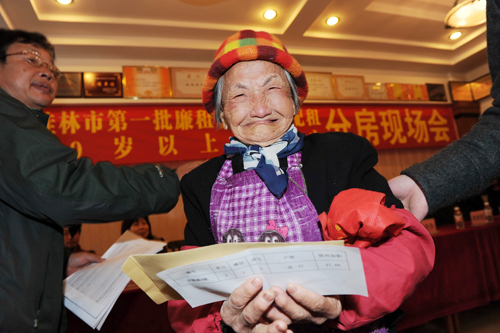|
 |
|
AFFORDABLE LIVING: Tang Yumei, 82, is overjoyed to receive a low-rent house by means of drawing lots in the city of Guilin, capital of south China's Guangxi Zhuang Autonomous Region on December 9, 2011 (XINHUA) |
The Chinese Government set a series of targets concerning the improvement of people's livelihood in 2011, the first year of 12th Five-Year Plan (2011-15). These targets are related to affordable house construction, commodity price control, tax reduction, social security improvement, increasing employment and guaranteeing education.
Low-income houses
Target: Use 103 billion yuan ($16.27 billion) in 2011 to start construction or renovation of 10 million housing units for low-income residents and those living in run-down areas, and renovate dangerous houses for 1.5 million households in rural areas, with focus shifting from quantity to quality.
Year-end performance: This year, China has allocated a total of 152.2 billion yuan ($24.04 billion) and over 10 million low-income housing units were under construction a month ahead of schedule, according to statistics issued on October 25 by the Ministry of Housing and Urban-Rural Development.
Analysis: "Despite the difficulty for the government to begin construction of all the 10 million low-income housing units within the year, affordable homes account for only less than 7 percent of the total, far lower than that in developed countries and some developing countries," said Hu Guangwei, a sociologist at the Sichuan Academy of Social Sciences in southwest China's Sichuan Province. "The achievements acquired now are, to a great extent, only setoffs of debts owed in the past, Hu, said.
Construction of low-income houses is in the limelight. However, quality problems appeared in many areas. "Projects benefiting people should not be ones that damage livelihood. In addition to requirements of quantity, the government should pay more attention to problems of quality, so as to prevent from churning out shoddy projects," said Hu.
Tax cuts
Target: Raise the threshold for personal income tax, in an aim to reasonably adjust tax structure, and reduce tax liabilities for middle- and low-income earners.
Year-end performance: A new personal income tax law was implemented on September 1, exempting 60 million people from paying personal income tax from that date onwards. The effect was obvious. Personal income tax in September was 3.3 billion yuan ($521 million) less than in August, and that in October was 9.9 billion yuan ($1.56 billion) less than in September. Further, thresholds for value-added tax and sales tax increased from November 1 to reduce taxes for businesses, along with exemption of stamp tax of loan contracts for small and tiny businesses.
Analysis: Raising the personal income tax threshold means that a large group of earners saw their incomes increase, said Sun Lijian, Vice President of the School of Economics at Fudan University. "Tax cuts for individuals and small businesses benefit the domestic consumer market in the age of a rising consumer price index (CPI)," Sun said.
China's fiscal revenue in the first 11 months hit 9,730.9 billion yuan ($1,537.12 billion), a year-on-year rise of 26.8 percent. Viewing from financial power, the government should conduct overall tax cut reform, especially reform on indirect taxes, so as to make a sound development environment for real economies' operation, said Lian Ping, chief economist at the Bank of Communications.
"Although China cut direct taxes and part of indirect taxes in 2011, it didn't reduce taxes for the manufacturing industry, which is one of the largest tax contributors, leaving a large room for tax cuts in the future," said Lian.
|
